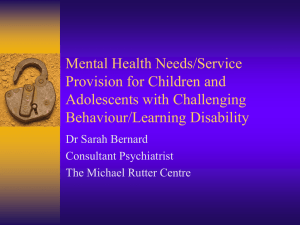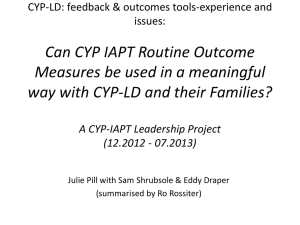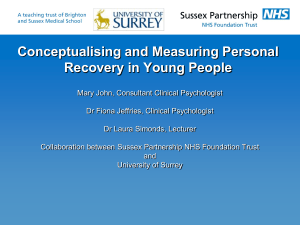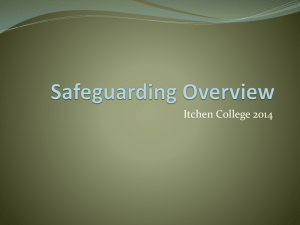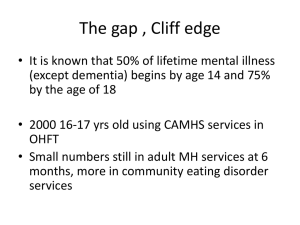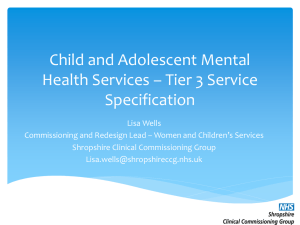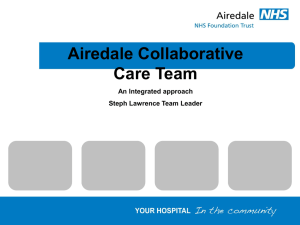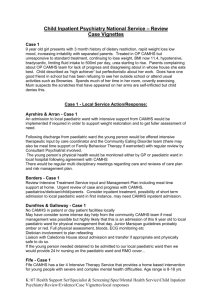Division Response - Royal College of Psychiatrists
advertisement
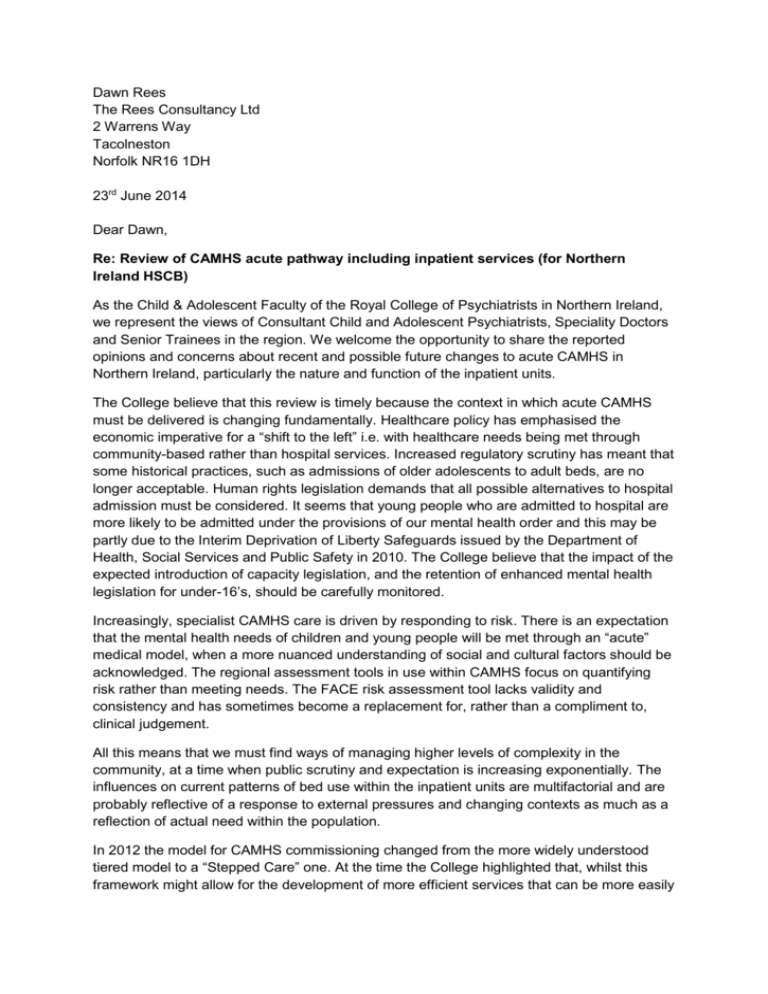
Dawn Rees The Rees Consultancy Ltd 2 Warrens Way Tacolneston Norfolk NR16 1DH 23rd June 2014 Dear Dawn, Re: Review of CAMHS acute pathway including inpatient services (for Northern Ireland HSCB) As the Child & Adolescent Faculty of the Royal College of Psychiatrists in Northern Ireland, we represent the views of Consultant Child and Adolescent Psychiatrists, Speciality Doctors and Senior Trainees in the region. We welcome the opportunity to share the reported opinions and concerns about recent and possible future changes to acute CAMHS in Northern Ireland, particularly the nature and function of the inpatient units. The College believe that this review is timely because the context in which acute CAMHS must be delivered is changing fundamentally. Healthcare policy has emphasised the economic imperative for a “shift to the left” i.e. with healthcare needs being met through community-based rather than hospital services. Increased regulatory scrutiny has meant that some historical practices, such as admissions of older adolescents to adult beds, are no longer acceptable. Human rights legislation demands that all possible alternatives to hospital admission must be considered. It seems that young people who are admitted to hospital are more likely to be admitted under the provisions of our mental health order and this may be partly due to the Interim Deprivation of Liberty Safeguards issued by the Department of Health, Social Services and Public Safety in 2010. The College believe that the impact of the expected introduction of capacity legislation, and the retention of enhanced mental health legislation for under-16’s, should be carefully monitored. Increasingly, specialist CAMHS care is driven by responding to risk. There is an expectation that the mental health needs of children and young people will be met through an “acute” medical model, when a more nuanced understanding of social and cultural factors should be acknowledged. The regional assessment tools in use within CAMHS focus on quantifying risk rather than meeting needs. The FACE risk assessment tool lacks validity and consistency and has sometimes become a replacement for, rather than a compliment to, clinical judgement. All this means that we must find ways of managing higher levels of complexity in the community, at a time when public scrutiny and expectation is increasing exponentially. The influences on current patterns of bed use within the inpatient units are multifactorial and are probably reflective of a response to external pressures and changing contexts as much as a reflection of actual need within the population. In 2012 the model for CAMHS commissioning changed from the more widely understood tiered model to a “Stepped Care” one. At the time the College highlighted that, whilst this framework might allow for the development of more efficient services that can be more easily measured in terms of short term outcome, it would not necessarily allow for the considered long-term planning and evolution of more effective and comprehensive services overall. This problem is compounded by lack of clarity around how CAMHS services have been commissioned historically. There is a tendency towards circular arguments between commissioners and providers as to which services were, or were not, included in historically funding arrangements e.g. services for under-5’s. There is a widely held (although debated) view that, whilst demand on mental health services in terms of numbers of referrals has stayed relatively constant over recent years, those who do seek help are presenting with more complex needs and greater expectations from services. In this context, the provision of acute care is being reframed, with short-term assessment and crisis resolution becoming the predominant model at Steps 4 and 5 of the CAMHS model. This is concerning to the College. Resources have largely been focussed on managing short-term risk. In terms of the inpatient units, this changing ethos has been evidenced through developments such as the admission of under-12’s being deemed “undesirable” and some beds being “managed” so that only emergency rather than planned admissions are being accepted. Clinicians have sensed a drive for increased turnover within the inpatient units. This is not always appropriate and depends on the development of more robust step-up and step-down pathways, with better planned and resourced community services. There will always be a cohort of young people who will benefit from planned and / or longer-term admissions. Specialist CAMHS continues to operate with a legacy of chronic under-funding, we receive a much lower percentage of the total mental health budget than elsewhere in the U.K. The development of crisis assessment teams has been very positive, but we should ensure they do not become the only pathway to inpatient care or necessarily the main focus of new or re-investment. CAMHS must be adequately resourced at all steps / tiers to ensure services are comprehensive and future-proof. The College would welcome further scrutiny as to whether crisis / intensive treatment teams function differently according to their geographical location. There is a sense that adolescents presenting with high-risk behaviours (e.g. acute suicidality alongside altered mental state due to drug use and / or social care concerns) are more likely to be admitted if they present in the Greater Belfast area, whereas in more remote areas such cases would be managed locally. Some senior clinicians believe that there is a need for smaller inpatient facilities in areas distant from Belfast; certainly our transport and technology systems are not conducive to family and community life being protected during times of inpatient treatment for those young people coming from more remote, rural regions. The College also believe that careful consideration should be given to the need for increased numbers of social care beds that offer a high level of support or secure care. There is a concern that often young people are admitted to mental health units at times of crisis because it is not safe for them to remain in the community. Care pathways should be developed which allow careful multiagency planning and cooperation and the resource implications of this should be fully considered. Community-based CAMHS clinicians have noticed increasing difficulty in accessing planned admissions and there is also a sense of their decreased confidence in the value of seeking admission for young people being managed in outpatient CAMHS. It seems that most admissions are of older adolescents with complex, intractable difficulties and these admissions happen in an unplanned way. Outpatient treatment may not have been optimised, assessment and treatment goals are less clear and discharge planning is difficult (leading to increased length of stay). Demands on the staff team have increased, and this appears to have had a negative impact on staff-turnover. Clinicians are also aware that various review bodies (RQIA, QNIC etc.) have highlighted concerns about the units, which may make people less likely to seek admission because of concerns about the quality of experience or outcome. Others believe themselves that the unit has become a less suitable environment for younger or more vulnerable clients, because of the range of behaviours they may witness and emulate. Despite all the issues outlined above, bed occupancy levels in Beechcroft have been variously reported at 80% to 110%. The figure of 80% represents actual numbers of beds in use at midnight i.e. not including beds held for young people on leave, so 110% might be a more accurate representation of demand. We have previously sought reassurance from the commissioners that the overall bed compliment will not be reduced. The College document, “Building and Sustaining Specialist CAMHS” suggests a need for 43-72 mainstream CAMHS beds and 11-15 I.D. CAMHS beds across the region. Those beds should run at 85% maximum average occupancy. Whilst the majority of these beds should be for adolescents, the College recognises a clear need for specialist beds for children under-13. These figures are intended to be a general guide for service-planners in the U.K. In Northern Ireland the under-18 population is 27-32% greater than other UK regions. The College would strongly challenge any view that the need for beds has been reduced because crisis teams have been established. There is a need for Step 5 CAMHS to contribute to the overall management of cases that present longer-term complexity and risk, sometimes by intervening early. Whilst we agree with commissioners that “acute” should not always be defined by the presence of a bed, neither should it always be defined as responding to high risk, crisis presentations. Often clinicians may seek admission to address specific diagnostic questions or to optimise complex treatment regimes. On occasions, they admissions of younger children and / or families will be beneficial and admission to a suitable unit should be easily achievable. In terms of intellectual disability services specifically, the Iveagh Unit has had to operate in a context of entirely inadequate community services. Children and young people with intellectual disability have very limited access to specialist, multidisciplinary, therapeutic CAMHS. In some trust areas there are no specialist residential provisions for those young people who are able to live at home. The pattern is of late, complex presentations to inpatient services with very limited options to support a planned discharge, which leads to the phenomena of “bed-blocking”. For Iveagh to be able to function efficiently there will need to be a significant increase in community-based services. The College advocate the need for better training and development pathways for CAMHS practitioners and the need to ensure better retention of experienced practitioners, with less reliance on use of staff on short-term contracts. The inpatients unit need to retain a cohort of staff with particular expertise in meeting the therapeutic needs of young people in in-patient care. To achieve this there needs to be improved pathways for training and career progression. The College are particularly concerned about the limited involvement to date of senior clinicians in discussions about changes to the inpatient units. They have had limited opportunity to influence decisions which have been taken or proposed. We want to see more robust engagement of clinicians in the planning of acute / inpatient services. The importance of clinical leadership should be recognised at a strategic level. The experience of both inpatient and community-based Consultants will be valuable in helping to shape services that are truly responsive to the needs of the population. We believe there is a role for improved shared decision-making and joint-working between community- and hospital-based services, both in terms of general service panning and with regard to individual case management. The interface between hospital and community should not be mediated via crisis teams alone, the College feel strongly that it should be possible to plan admissions for children and young people who are being managed longterm at Step 3 and who require a more specialist assessment. There should be clear pathways which allow psychiatrists working in community teams to participate in collaborative admission and discharge planning processes and there may need to be separate pathways for crisis and planned admissions. Community clinicians need to be able to rely on timely admissions when these become necessary. Given the demands on clinician’s time and geographical considerations, the system should be responsive, flexible and easy-to-negotiate. Much of this could be achieved through out-reach / in-reach models and greater use of technology. It is important that changes to services are incremental and intensively evaluated in a prospective manner, to ensure that change is positive. Quality should be the organising principle of all we do and, where the inpatients units need better resources to achieve better outcomes, this should be recognised. We would like to see outcomes and experience of service being captured more meaningfully to help inform future changes to the nature of Step 4 and 5 services, rather than changes being made on the basis of more rudimentary data or conceptual ideas. The College members look forward to working with each other, managers and commissioners in the months ahead as we seek to address the needs of the population we care for and to provide the highest possible standards of care for those children and young people who are in need of specialist mental health services. We trust these comments will be helpful in the context of the overall review. Yours Sincerely Dr Heather Hanna Consultant Child & Adolescent Psychiatrist Chair, Child & Adolescent Faculty RCPsychNI
